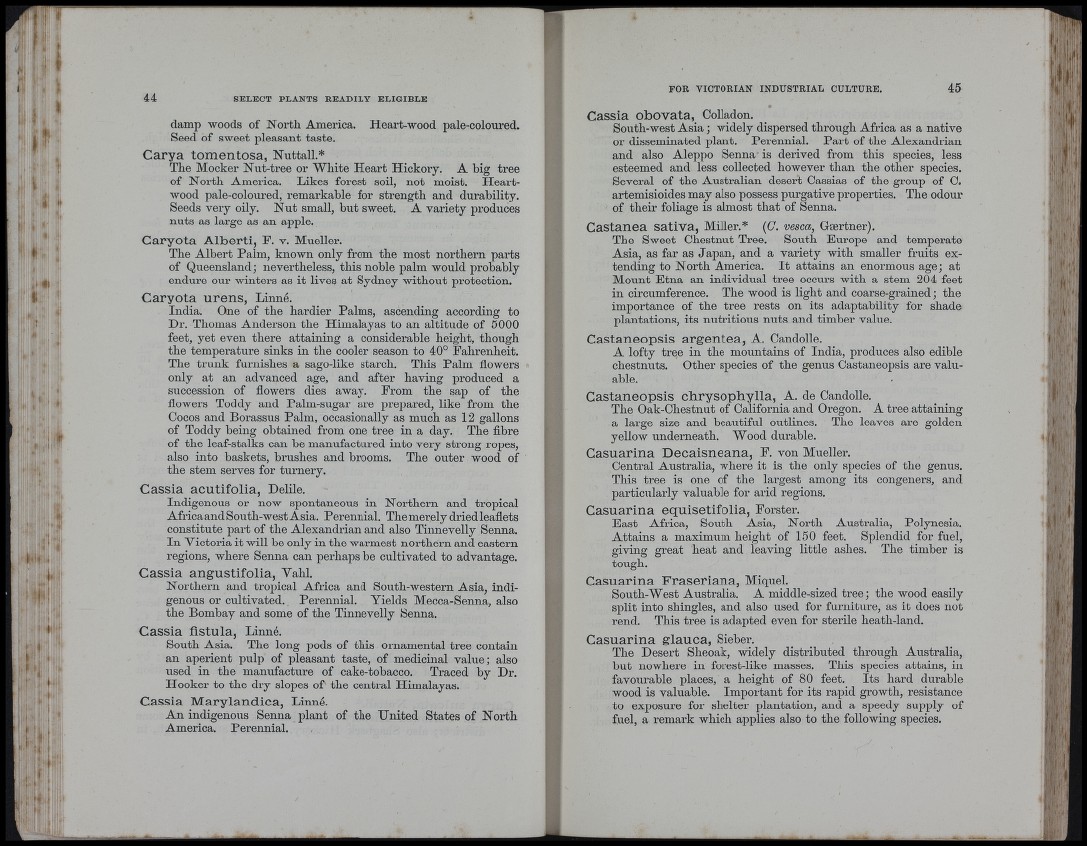
■h
■I, I*
' t(!t
- Il
I
damp woods of North America. Heart-wood pale-coloured.
Seed of sweet pleasant taste.
Carya tomentosa, Nuttall.*
The Mocker Nut-tree or White Heart Hickoiy. A big tree
of North America. Likes forest soil, not moist. Heart-
wood pale-coloured, remarkable for strength and durability.
Seeds very oily. Nut small, but sweet. A variety produces
nuts as large as an apple.
Caryota Alberti, F. v. Mueller.
The Albert Palm, known only from the most northern parts
of Queensland; nevertheless, this noble palm would probably
endure our winters as it lives at Sydney without protection.
Caryota urens, Linné.
India. One of the hardier Palms, ascending according to
Dr. Thomas Anderson the Himalayas to an altitude of 5000
feet, yet even there attaining a considerable height, though
the temperature sinks in the cooler season to 40° Fahrenheit.
The trunk furnishes a sago-like starch. This Palm flowers
only at an advanced age, and after having produced a
succession of flowers dies away. From the sap of the
flowers Toddy and Palm-sugar are prepared, like from the
Cocos and Borassus Palm, occasionally as much as 12 gallons
of Toddy being obtained from one tree in a day. The fibre
of the leaf-stalks can be manufactured into very strong ropes,
also into baskets, brushes and brooms. The outer wood of
the stem serves for turnery.
Cassia acutifolia, Defile.
Indigenous or now spontaneous in Northern and tropical
Africa and South-west Asia. Perennial. The merely dried leaflets
constitute part of the Alexandrian and also Tinnevelly Senna.
In Victoria it will be only in the warmest northern and eastern
regions, where Senna can perhaps be cultivated to advantage.
Cassia angustifolia, Vabl.
Northern and tropical Africa and South-western Asia, indigenous
or cultivated. Perennial. Yields Mecca-Senna, also
the Bombay and some of the Tinnevelly Senna.
Cassia fistula, Linné.
South Asia. The long pods of this ornamental tree contain
an aperient pulp of pleasant taste, of medicinal value; also
used in the manufacture of cake-tobacco. Traced by Dr.
Hooker to the dry slopes of the central Himalayas.
Cassia Marylandica, Linné.
An indigenous Senna plant of the United States of North
America. Perennial.
FOR VICTORIAN INDUSTRIAL CULTURE. 45
Cassia obovata, Colladon.
South-west A sia ; widely dispersed through Africa as a native
or disseminated plant. Perennial. P a rt of the Alexandrian
and also Aleppo Senna is derived from this species, less
esteemed and less collected however than the other species.
Several of the Australian desert Cassias of the group of C.
artemisioides may also possess purgative properties. The odour
of their foliage is almost that of Senna.
Castanea saliva, Miller.* {G. vesca, Gsertner).
The Sweet Chestnut Tree. South Europe and temperate
Asia, as far as Japan, and a variety with smaller fruits extending
to North America. I t attains an enormous age; at
Mount Etna an individual tree occurs with a stem 204 feet
in circumference. The wood is light and coarse-grained; the
importance of the tree rests on its adaptability for shade
plantations, its nutritious nuts and timber value.
Castaneopsis argentea, A. Candolle.
A lofty tree in the mountains of India, produces also edible
chestnuts. Other species of the genus Castaneopsis are valuable.
Castaneopsis cbrysophylla, A. de Candolle.
The Oak-Chestnut of California and Oregon. A tree attaining
a large size and beautiful outlines. The leaves are golden
yellow underneath. Wood durable.
Casuarina Decaisneana, E. von Mueller.
Central Australia, where it is the only species of tbe genus.
This tree is one of the largest among its congeners, and
particularly valuable for arid regions.
Casuarina equisetifolia, Forster.
East Africa, South Asia, North Australia, Polynesia.
Attains a maximum height of 150 feet. Splendid for fuel,
giving great heat and leaving little ashes. The timber is
tough.
Casuarina Fraseriana, Miquel.
South-West Australia. A middle-sized tree; the wood easily
split into shingles, and also used for furniture, as it does not
rend. This tree is adapted even for sterile heath-land.
Casuarina glauca, Sieber.
The Desert Sheoak, widely distributed through Australia,
but nowhere in forest-like masses. This species attains, in
favourable places, a height of 80 feet. Its hard durable
wood is valuable. Important for its rapid growth, resistance
to exposure for shelter plantation, and a speedy supply of
fuel, a remark which applies also to the following species.
I:
4 1
'f
(. ,
i, ,
■i•i ' :. ■ '■
\
,1a
i ' i
-I ' fit.l."